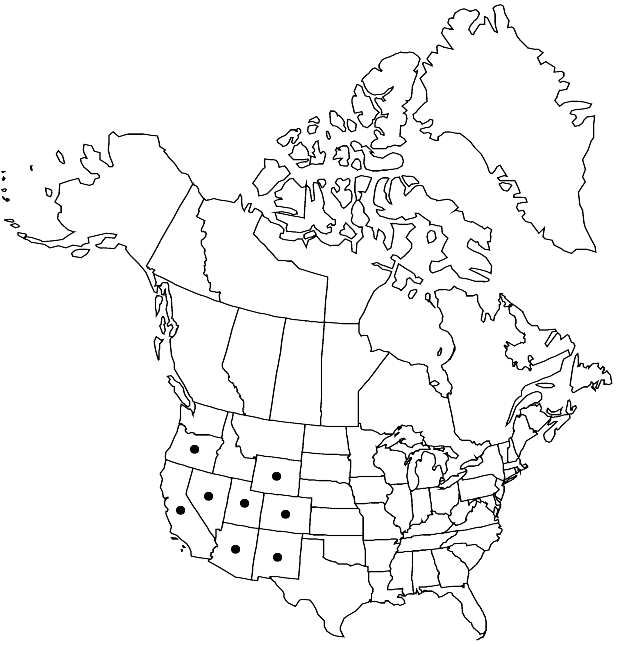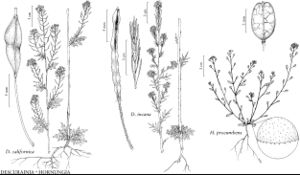Difference between revisions of "Descurainia californica"
in H. G. A. Engler, Pflanzenr. 86[IV,105]: 330. 1924.
FNA>Volume Importer |
FNA>Volume Importer |
||
| Line 10: | Line 10: | ||
|name=Smelowskia californica | |name=Smelowskia californica | ||
|authority=A. Gray | |authority=A. Gray | ||
| + | |rank=species | ||
|publication_title=Proc. Amer. Acad. Arts | |publication_title=Proc. Amer. Acad. Arts | ||
|publication_place=6: 520. 1865 | |publication_place=6: 520. 1865 | ||
| Line 16: | Line 17: | ||
|name=Sisymbrium californicum | |name=Sisymbrium californicum | ||
|authority=(A. Gray) S. Watson | |authority=(A. Gray) S. Watson | ||
| + | |rank=species | ||
}} {{Treatment/ID/Synonym | }} {{Treatment/ID/Synonym | ||
|name=Sophia leptostylis | |name=Sophia leptostylis | ||
|authority=Rydberg | |authority=Rydberg | ||
| + | |rank=species | ||
}} | }} | ||
|hierarchy=Brassicaceae;Brassicaceae tribe Descurainieae;Descurainia;Descurainia californica | |hierarchy=Brassicaceae;Brassicaceae tribe Descurainieae;Descurainia;Descurainia californica | ||
| Line 42: | Line 45: | ||
-->{{#Taxon: | -->{{#Taxon: | ||
name=Descurainia californica | name=Descurainia californica | ||
| − | |||
|authority=(A. Gray) O. E. Schulz in H. G. A. Engler | |authority=(A. Gray) O. E. Schulz in H. G. A. Engler | ||
|rank=species | |rank=species | ||
| Line 57: | Line 59: | ||
|publication year=1924 | |publication year=1924 | ||
|special status= | |special status= | ||
| − | |source xml=https://jpend@bitbucket.org/aafc-mbb/fna-data-curation.git/src/ | + | |source xml=https://jpend@bitbucket.org/aafc-mbb/fna-data-curation.git/src/f50eec43f223ca0e34566be0b046453a0960e173/coarse_grained_fna_xml/V7/V7_820.xml |
|tribe=Brassicaceae tribe Descurainieae | |tribe=Brassicaceae tribe Descurainieae | ||
|genus=Descurainia | |genus=Descurainia | ||
Revision as of 22:19, 16 December 2019
Annuals or biennials; eglandular; usually pubescent, trichomes dendritic, sometimes glabrous distally. Stems erect, unbranched basally, branched distally, (1.3–)2–10.5(–13.5) dm. Basal leaves: petiole 0.4–4.2 cm; blade pinnate, oblanceolate to obovate in outline, 1.5–6 cm, lateral lobes [2–4 (or 5) pairs], lanceolate, (5–22 × 1–5 mm), margins usually entire or crenate to incised, rarely lobed. Cauline leaves sessile or shortly petiolate; blade smaller distally, distal lobes often narrower, surfaces sparsely pubescent. Racemes considerably elongated in fruit. Fruiting pedicels divaricate to ascending or suberect, often straight, 3–9(–11) mm. Flowers: sepals spreading, yellowish, oblong, 0.9–1.5 mm, glabrous; petals oblanceolate, 1.1–1.8 × 0.4–0.6 mm; median filaments 0.8–1.4 mm; anthers 0.3–0.4 mm. Fruits divaricate to erect, fusiform, not torulose, (2–)3–5(–6) × (0.8–)1–1.3 mm, (long-acute at both ends); valves each with obscure midvein; septum not veined; ovules 4–12 per ovary; style (0.2–)0.3–0.6(–0.8) mm, glabrous. Seeds uniseriate, light brown, ellipsoid, 1–1.4 × 0.6–0.8 mm. 2n = 14.
Phenology: Flowering Jun–Aug.
Habitat: Disturbed areas in pinyon-juniper, dry hillsides, decomposed granite slopes, sagebrush, moist roadsides, open woods, fir-spruce or aspen communities, gravel and talus slopes
Elevation: 1700-3400 m
Distribution

Ariz., Calif., Colo., Nev., N.Mex., Oreg., Utah, Wyo.
Discussion
Selected References
None.
